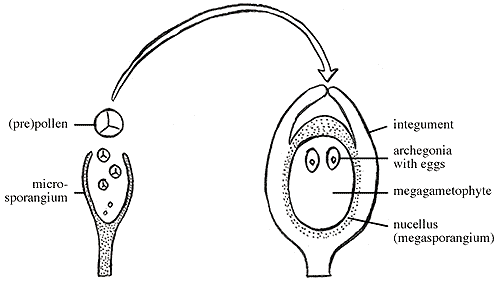







Being the first seed plants, lyginopterids competed with spore-dispersing plants for both nutrients and habitat area. However, lyginopterids had the advantage of the seed, which protects and disperses the embryo and supplies the young embryo with nutrients.
The lyginopterids are thought of as vine-like plants, probably less than two meters tall and probably growing upon other plants for support, making them a kind of epiphyte. Evidence supporting the hypothesis that lyginopterids were vine-like includes the widely spaced, spiral arrangement of the leaves around a rather slender stem. Additionally, the presence of many auxiliary buds is anatomical evidence that many species of lyginopterids were vine-like because auxiliary buds indicate a lot of potential for branching, or spreading out. Such spreading out is characteristic of vines.
There is still a question concering whether or not the lyginopterids relied on other plants for structural support or whether they formed dense thickets. They are generally considered to be small, scrambling lianas or possibly shrubs. Nevertheless, since they are considered to be vine-like they would have lived in a somewhat damp environment, probably with rather large trees upon which to scramble.

Lyginopterid pollination : Pollination in lyginopterids is not that different from pollen transfer in other seed plants. A "male" chamber (above, at left) produces pollen, which is then carried by wind or some other dispersal agent to the "female" chamber (above, at right) where the egg is housed. In lyginopterids, as in other "primitive" seed plants, a tube then grows from the pollen grain to the egg chamber, and sperm swim down the inside of this tube to reach the egg cell.
The lyginopterids' most interesting features are their reproductive organs, for they are what make these first seed plants distinct. Lyginopterids bore cupules, which can be described as tulip shaped structures. A cupule's function is to enclose and protect the ovules. As the ovules developed, they eventually abscised and fell out, leaving the cupules empty.
Surprisingly, no lygintopterid megagametophyte has never been reported, although megaspores have been described. Some speculate that the pollen and seed structures were on different plants. However, this is a gray area due to the fact that we have only fragmentary fossils to look at, making it difficult to come to a solid conclusion.
The lyginopterids were probably pollinated by wind. Evidence of this lies in the fact that many of their seeds have hairs on their surface, probably to trap wind-born pollen. These glandular hairs might have attracted seed dispersers, protected dispersed seeds or secreted chemicals that discouraged the growth of other young plants.


